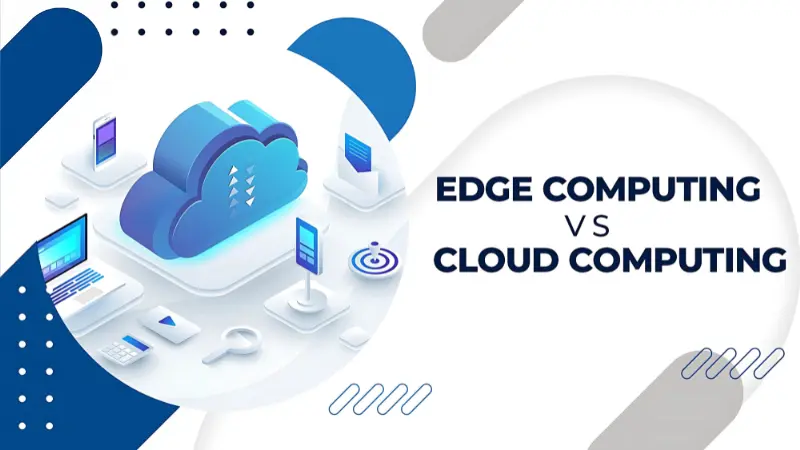Every day, companies and individuals manage tons of data. Two common approaches have emerged: Edge Computing and Cloud Computing. Each handles data differently. In this blog post, we explain what these methods are all about. We also discuss their pros and cons and highlight the best times to use each. Read on to see which might work best for you.

Edge Computing is a decentralized framework that processes data near its source (e.g., IoT sensors, smartphones, or industrial machines) instead of sending it to a centralized cloud. By minimizing reliance on distant servers, it reduces latency and enhances real-time decision-making.
- Low Latency: Immediate data processing at the “edge” of the network eliminates delays, critical for applications like autonomous vehicles and robotics.
- Enhanced Security: Less data transmission reduces exposure to cyber threats. Sensitive information stays localized, making it an appealing option for industries handling critical data. IBM Hybrid Cloud solutions often incorporate edge computing to improve security.
- Bandwidth Efficiency: Reduces the volume of data sent to the cloud, lowering network congestion and costs. This is particularly useful in remote locations where cloud connectivity might not be reliable.
- Limited Resources: Edge devices often lack the storage and processing power of cloud servers. If you’re wondering how to scale AI-driven applications for edge devices, check out 7 AI Programming Languages You Must Know in 2025.
- Complex Maintenance: Deploying edge infrastructure across multiple locations complicates management. Organizations using DevOps practices can optimize edge computing—learn about the 10 Essential DevOps Tools for 2025.
- Higher Initial Costs: Specialized hardware and localized setups can be expensive compared to cloud-based solutions.
Cloud Computing delivers on-demand IT resources (servers, databases, software) over the internet. Users access shared, scalable infrastructure managed by third-party providers like AWS, Microsoft Azure, and Google Cloud.
- Scalability: Easily adjust resources based on demand without physical hardware investments. Businesses needing rapid expansion often use cloud-based DevOps tools like GitHub and GitLab.
- Cost-Effective: Pay-as-you-go models eliminate upfront infrastructure costs, making it an ideal choice for startups and businesses managing large-scale applications.
- High Availability: Providers guarantee uptime, ensuring reliable access for mission-critical applications. Learn about API integrations in A Complete Guide to API Development.
- Security Risks: Centralized data storage attracts cyberattacks; breaches can expose vast datasets. Organizations should follow Cloud Security Alliance (CSA) best practices.
- Internet Dependency: Requires stable connectivity—outages disrupt access to essential applications.
- Limited Customization: Users rely on providers’ configurations, restricting control over infrastructure.
| Parameter | Edge Computing | Cloud Computing |
|---|---|---|
| Data Processing | At the network’s edge (near devices) | Centralized data centers |
| Latency | Ultra-low (milliseconds) | Higher (depends on network speed) |
| Bandwidth Usage | Minimal | High |
| Cost Structure | High initial setup costs | Pay-per-use, lower upfront costs |
| Scalability | Challenging (requires hardware updates) | Instant and seamless |
| Ideal Use Cases | Real-time analytics, IoT, autonomous systems | Web apps, email, long-term |
| Security | Localized data reduces exposure | Centralized data increases vulnerability |
When to Use Edge Computing?
- Applications needing real-time responses (e.g., factory robots, AR/VR).
- Remote locations with unstable internet where traditional cloud solutions are unreliable.
- Industries handling sensitive data like healthcare and finance, where localized storage is preferred.
When to Use Cloud Computing?
- Non-time-sensitive tasks (e.g., CRM software, backups, and internal tools).
- Projects requiring massive storage or complex computations, such as AI model training.
- Startups needing affordable, scalable solutions without investing in dedicated IT infrastructure.
Synergy Between Edge and Cloud Computing
Hybrid models are increasingly popular. For example, edge devices process urgent data locally, while non-critical information is sent to the cloud for deep analysis. This balances speed, efficiency, and cost, ensuring optimal performance for businesses.
Frequently Asked Questions (FAQs)
1. Can Edge Computing Replace Cloud Computing?
No, they complement each other. Edge handles real-time tasks, while the cloud manages large-scale storage and complex analytics.
2. Which Is More Secure: Edge or Cloud?
Edge offers inherent security benefits by limiting data transmission. However, physical tampering of edge devices is a risk. Cloud security depends on the provider’s protocols—review best practices from Cloud Security Alliance (CSA).
3. Does Edge Computing Require the Internet?
Edge systems can operate offline for local processing. The internet is needed only to sync results with the cloud.
4. What Industries Benefit Most from Edge Computing?
- Manufacturing (predictive maintenance).
- Healthcare (real-time patient monitoring).
- Transportation (self-driving cars).
5. How Does Cloud Computing Reduce Costs?
Cloud eliminates capital expenses for hardware; users pay only for consumed resources, making it ideal for startups and enterprises alike.
6. Can Small Businesses Use Edge Computing?
Yes, but initial costs may be prohibitive. Cloud computing is often more accessible for SMBs.
7. Is Latency the Only Factor to Choose Edge?
No—privacy, bandwidth savings, and offline functionality also matter.
8. What’s the Future of These Technologies?
5G and AI will drive edge adoption, while cloud platforms will evolve with quantum computing and AI-as-a-Service (AIaaS).
Final Thoughts
Edge and Cloud Computing serve distinct purposes but coexist in modern tech ecosystems. Edge excels in speed and efficiency for localized tasks, while the cloud offers unmatched scalability and affordability. Businesses must evaluate their latency, budget, and data needs to choose the right mix.